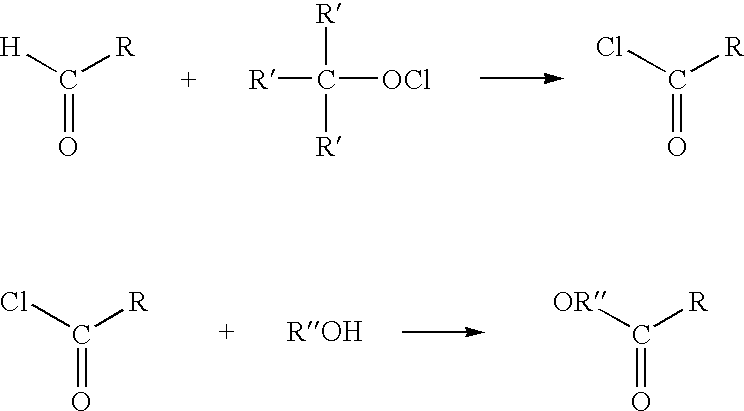Process for the conversion of aldehydes to esters
- Summary
- Abstract
- Description
- Claims
- Application Information
AI Technical Summary
Problems solved by technology
Method used
Image
Examples
example 1
[0039] 28.5 mL of carbon tetrachloride and 1.0 g of acrolein (17.8 mmole) were loaded into a three-neck 100 mL nitrogen-purged flask equipped with magnetic stirrer, condenser and thermometer. 2.32 g (21.5 mmole) of t-butyl hypochlorite was then added dropwise over a period of approximately 20 minutes while the temperature was maintained at less than 30.degree. C. by cooling throughout the addition. The reaction mixture was stirred for three hours after which the reaction was considered to be complete because no more t-butyl hypochlorite (t-BuOCl) was detectable by gas chromatography (GC). 2.85 g (89 mmole) of methanol was added over a period of approximately thirty minutes. After approximately 60 minutes the reaction was considered complete. Selectivity of MA was 80.7% by GC.
example 2
[0040] The procedure of Example 1 was repeated except 6.611 g of t-butanol was used instead of methanol. The process conditions and yield are shown in Table 1.
example 3
[0041] The procedure of Example 1 was repeated except 11.615 g of 2-ethylhexanol was used instead of methanol. The process conditions and yield are shown in Table 1.
PUM
| Property | Measurement | Unit |
|---|---|---|
| Angle | aaaaa | aaaaa |
| Angle | aaaaa | aaaaa |
| Angle | aaaaa | aaaaa |
Abstract
Description
Claims
Application Information
 Login to View More
Login to View More - R&D
- Intellectual Property
- Life Sciences
- Materials
- Tech Scout
- Unparalleled Data Quality
- Higher Quality Content
- 60% Fewer Hallucinations
Browse by: Latest US Patents, China's latest patents, Technical Efficacy Thesaurus, Application Domain, Technology Topic, Popular Technical Reports.
© 2025 PatSnap. All rights reserved.Legal|Privacy policy|Modern Slavery Act Transparency Statement|Sitemap|About US| Contact US: help@patsnap.com

